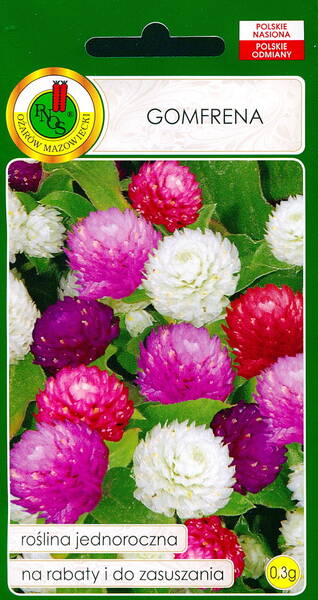Spectacular in winter bouquets, perfectly retains color!
Highly branched, compact gomphrena bushes in Estonian conditions do not exceed 30-35 cm, although in the southern regions it can grow up to 60 cm. The diameter of the inflorescence is 3-4 cm.
The heat-loving drought-resistant letnik is valued for its original inflorescences with a diameter of 3-4 cm, purple, pink, salmon and white. Belongs to the group of dried flowers. Dried inflorescences retain their color and shape well, look spectacular in winter bouquets.
Gomphrena will wonderfully decorate sunny flower beds, borders, borders. A great place for her is an alpine hill. It is also suitable for the role of a potted plant on a sunny balcony and windowsill. Do not get carried away with top dressing, because gomphrena needs them only at the seedling stage: an excess of fertilizer leads to an increase in the vegetative mass to the detriment of flowering. Place gomphrena on light, well-drained, poor soils that are neutral in acidity.
Sowing seeds for seedlings in March. Seedlings appear after 2 weeks. After about 2 weeks, the seedlings dive into separate pots. Seedlings are planted in open ground in early June, in increments of 25-30 cm.
1,0 g = 800 seeds.
* Bachelor's button - Gomphrena globosa L.
Widespread in tropical America. An annual from the group of dried flowers. Forms highly branched bushes up to 35 cm high, in the southern regions up to 70 cm. Leaves on short petioles, elongated-elliptical, entire, bluish from omission. The flowers are clove-shaped, small, with membranous bracts of white, pink or purple color, collected in elongated-oval, capitate inflorescences up to 3-4 cm in diameter, located at the ends of the stems, sometimes on the lateral shoots emerging from the axils of the leaves. In the middle lane, seeds ripen only on the main shoot. In culture since 1714.
Less common undersized form (f. nana compacta) - up to 15 cm tall, with white or red inflorescences. One gram contains about 800 seeds.
Seeds of globe amaranth are sold mainly in the form of various mixtures of colors.
Location: since gomphrenas originate from the tropics, they need a sunny, warm location.
Soil: grow well only on loose and nutritious soil.
Care: the cultivation technique is similar to the cultivation of celosia and variegated amaranth species. Fertilizers for this crop must be applied very carefully, with an excess of organic fertilizers, it may not bloom. Top dressing with a full complex fertilizer is done only during the cultivation of seedlings and the first month after its planting in the ground, with the beginning of flowering, top dressing is stopped.
Reproduction: by sowing seeds in boxes in March. Shoots appear on the 14-16th day. 1.5-2 weeks after germination, they dive into pots with a diameter of 7-8 cm, boxes or greenhouse ridges. Gomphrena transplantation tolerates very well. Seedlings are planted in place in early June, maintaining a distance of about 25 cm between plants, in undersized varieties -15 cm.
Use: in flowerbeds, borders, borders, as a pot culture. Very effective in winter bouquets, as dried inflorescences retain their color and shape well.
Good flowering in gomphrena in our conditions can not be seen every year. In cold, rainy summers, plants can suffer from excess moisture and lack of heat, so if you want to get a quality gomphrena cut, then it is better to grow it in a greenhouse. But in a warm summer, this plant feels great in the open field and can be successfully used for borders, rabatok, in flower beds, in rock gardens, grown in flowerpots and pots.
For drying, gomphrenia shoots are cut off at a time when the inflorescences have reached their maximum size, but the lower scales have not yet begun to turn brown. After cutting the shoots in the axils of the leaves located on the stem below the cut point, new flower stalks begin to grow rapidly. Gomphrenu is dried by tying several shoots into small bunches and hanging them in a dry, darkened room.












